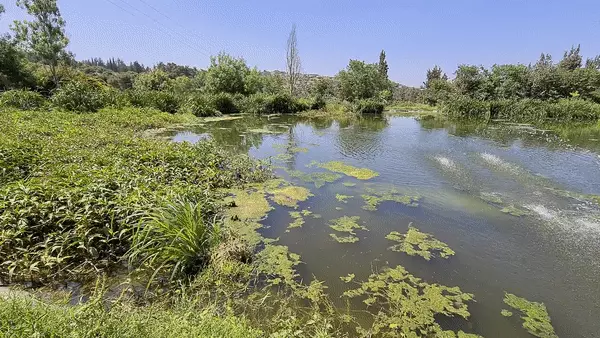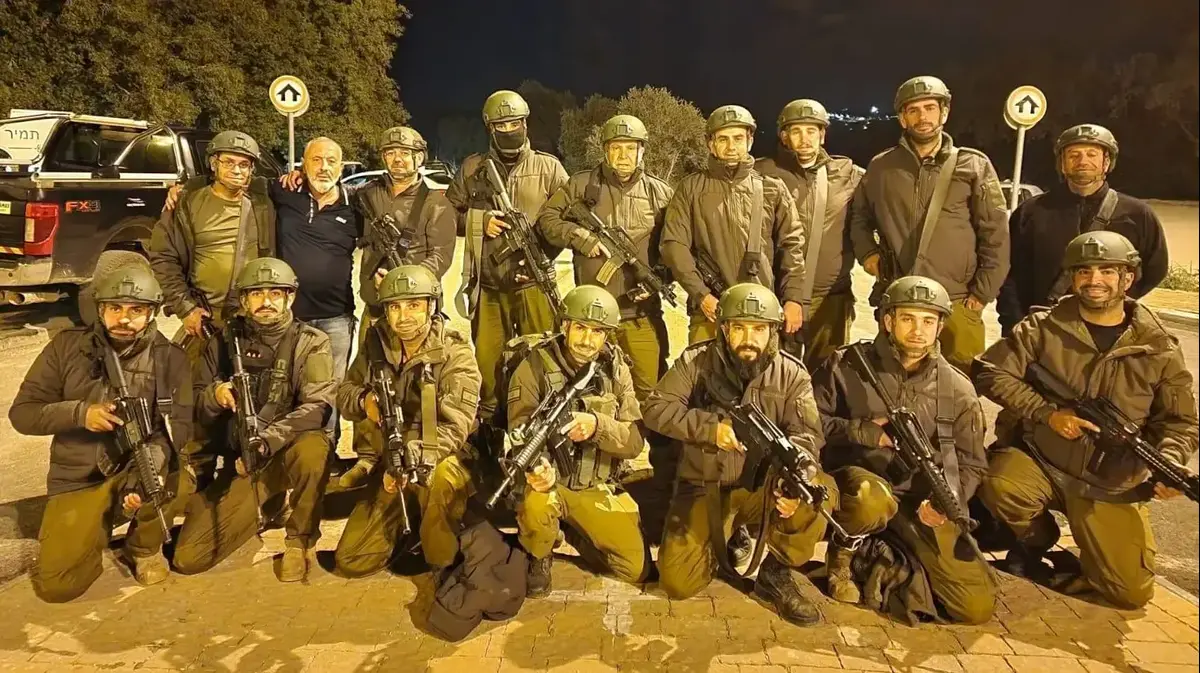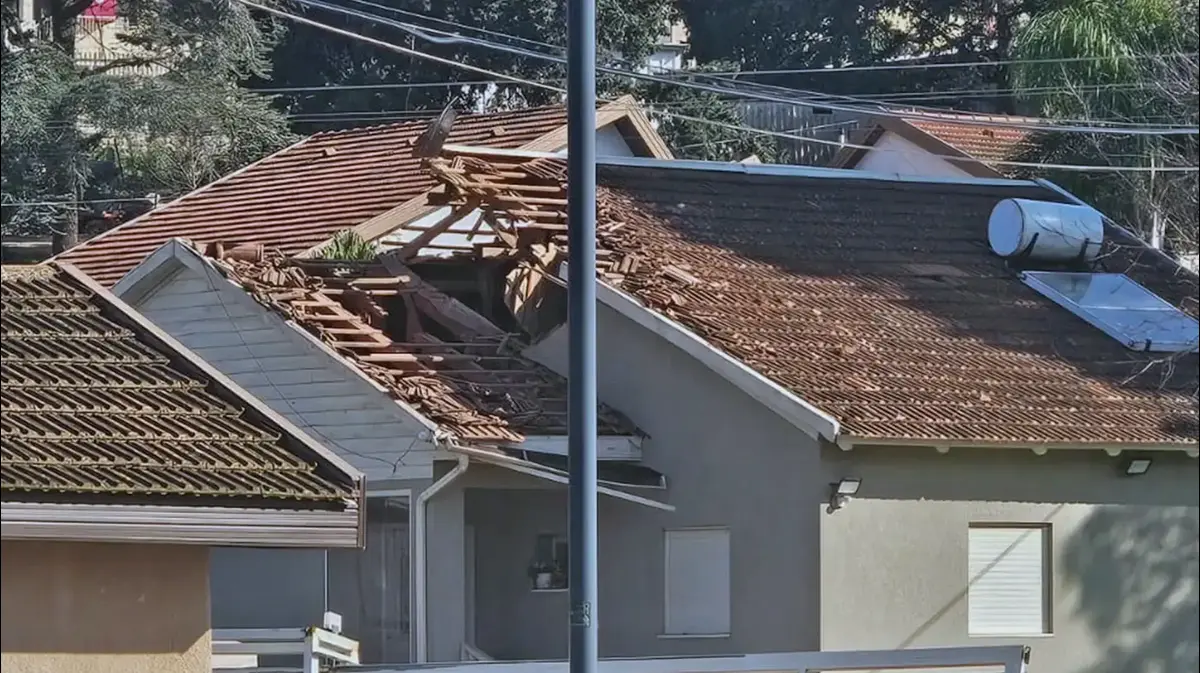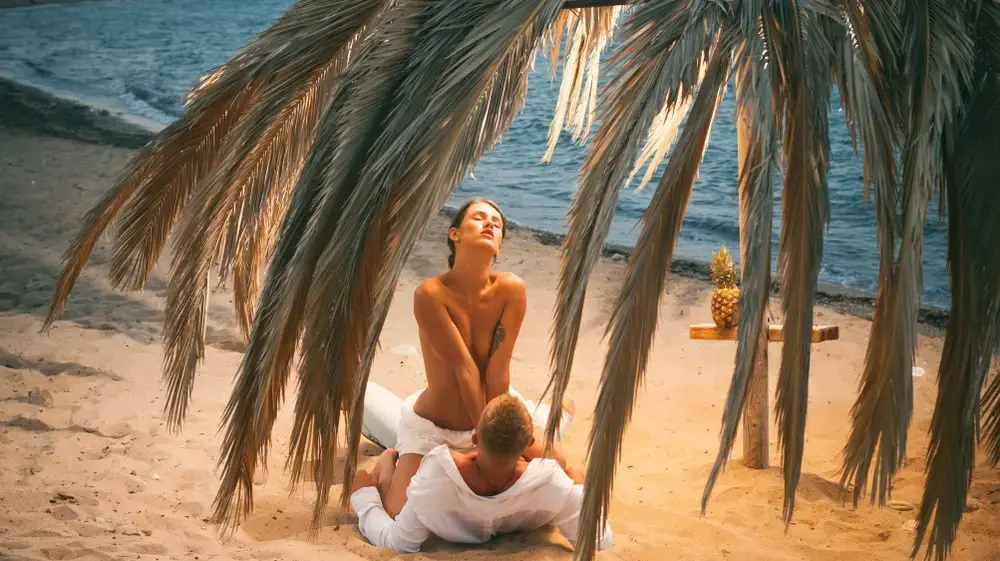The settlement that turned its sewer into a beautiful lake
In Kibbutz Harduf in the Lower Galilee, anthroposophy is not only in education but in all areas of life: from the bees take only excess honey, the sewage has become a flowering garden, the fruits are organic and people with various disabilities integrate as one person, because we are all harmed one way or another, no?
Ziv Reinstein
30/05/2022
Monday, 30 May 2022, 08:27 Updated: 08:33
Share on Facebook
Share on WhatsApp
Share on Twitter
Share on Email
Share on general
Comments
Comments
Inside an olive grove, Rei Saborai from Kibbutz Harduf set up a water facility for bees, just like a bowl of water that someone left for cats on the street.
Yes, it turns out that bees also drink and need water, and Rae, who as his name implies - is the friend of the bees - explains that I am looking at the first biodynamic beehive in the country.
"Biodynamic farming is learning what the cow / bee / lettuce needs - and giving it the best conditions to reach its maximum," he says, "and then the person gets back."
And this is perhaps the whole Torah of the Anthroposophical Kibbutz in the Lower Galilee
(even though it belongs to MA Jezreel Valley): Do not think only of yourself, you are not alone here in the world, if you give to another - you will receive equally and full of "clichés" that will make the lives of others good. More, and hence - yours too.
More on Walla!
From the bird's eye view: the cool seat that awaits Israeli tourists
To the full article
The "Semania" park in Kibbutz Harduf (Photo: Ziv Reinstein)
Not the kibbutz you know
And it's amazing that you can do different, better, healthier and better farming with animals.
Once it's the animals, and once it's man and nature, and basically everything is intertwined and responsible for each other's Well being.
And this is the concept that Kibbutz Harduf has been trying to instill in its members and the environment for exactly 40 years.
Harduf was established in 1982 at a time when settlements began to dot the Galilee with a different thought, such as Ma'ale Tzvia and the "Haiman" path, mountainous and transcendental meditation, as well as the veteran Yodfat and "Shachterists".
A time when a different perception was prevalent, mainly social and spiritual, that challenged the familiar kibbutz or moshav and Israeliness and man's interaction with his human, religious environment, connection to nature and in short - looking inside to check ourselves and what kind of person grew up in this country and how he wants to live In the future.
The persecutors were first cruisers, followers of the anthroposophy theory of Rudolf Steiner - an Austrian philosopher and architect, who is considered the father of the current.
His books are being translated and sold today at Yutke's nice "Haunted Restaurant" in a dedicated bookcase.
In general, Steiner is the model and inspiration for everything that happens in the kibbutz.
The members of the kibbutz, named after the stream haunted shrub that has become an ornamental shrub in almost every city in the country, refer to all their extensive activities as an "initiative." Which doubles its human volume during the day, while in the evening it empties, "says Michal Kerger Kalmanovich, artist and workshop facilitator for painting and drawing, who has lived in the kibbutz for more than 20 years. Michal explains that for every 250 members of the kibbutz, more than 250 men and women who come to receive certain treatment - if these are mentally ill (called "contenders"),
Or people with disabilities of different ages or people with special needs.
Everyone has the right framework for them, and not because someone is doing someone a favor or helping the weak, but because this is exactly where biodynamics and mutual benefit exist, since we are all somehow hurt and need this or that support, right?
Give the bees the best conditions.
Rei and the water facility he established (Photo: Walla !, Ziv Reinstein)
Here anthroposophy is a way of life, not just in school.
Kibbutz Harduf (Photo: Walla !, Ziv Reinstein)
Friends, not tenants
Wooden signs greet the conference at the kibbutz gates.
It seems that he has a lot of business to pursue, and quite a few tourists.
One of the most important and long-standing initiatives in the place started 27 years ago, and it comes from medical education in Germany.
The KMA organization -
K
Hila
from
Rafat B'Harduf
-
is actually two initiatives that have joined together:
Beit Tuvia -
a boarding school for children and youth who have been evicted from their homes for various reasons, and
Beit Elisha - a
hostel for people with special needs integrated into the kibbutz. "We call them 'friends' And not 'tenants' "explains Limor Karni, who together with Tamar Nachmias-Shefa manages the initiatives.
The members of Beit Elisha have a regular agenda, they participate in works in the vegetable garden and livestock, in handicraft and craft workshops, they have culture time and social life, and in a charming gallery cafe in Beit Elisha they sell their handicrafts: ceramics, cookies and breads they bake, granola and serve For a crowd of shakshuka, sandwiches, smoothies and other goodies on the menu.
Just delicious and the patio is lovely.
Groups that come can (by prior arrangement) get an explanation of the place and watch a movie about its work.
Elisha House.
052-8377915 (Tamar).
Social coffee that is both fun and important.
Kama Cafe (Photo: Walla !, Ziv Reinstein)
Ceramic items made by the members of Beit Elisha, and displayed for sale in a cafe (Photo: Walla !, Ziv Reinstein)
And look what a lovely courtyard there is in the cafe (Photo: Walla !, Ziv Reinstein system)
The sewer that became the lake
Many faces to him, to the treatment of Harduf.
Hagit Yakar, for example, is a clinical herbalist and food engineer, who left high-tech and realized that it does not contribute to her health and the community, and after half a day in the kibbutz she realized that she wanted to deal with herbs and nature.
After studying the field, including Maimonides' medicine, she began taking pick-up and herbal tours and making herbal theory, which was prevalent in every home hundreds of years ago in the area, accessible to the general public. Calendula from marigold.It is interesting to know that Hagit also teaches where to find a root in the soil called "bald licorice", which restores tissue and anti-inflammatory. You may know it as licorice, and you can chew and suck its sweet taste.
But it is not only the person who needs to be cared for.
In fact, there can be no connection of man without nature, of which he is in fact a part.
In 2003, Harduf decided to take responsibility not only for what they put in, but also for what they spend.
Thus, they established a kind of small sewage treatment plant of their own near the kibbutz, which treats the sewage effluent of the residents of Harduf.
Axel Ewald, a German environmental artist who fell in love with Israel and Efrat, and a trust in turning the local sewer into living water, joined the initiative.
Axel, together with the sculptor and environmental architect Reuven Aloro Cohen, designed a charming lake, which, using an ecological purification method of reed and gravel ponds, turned the bio into water that fills a lake, where aquatic vegetation was planted. Of the kibbutz. "But Axel did not rest on his laurels, and many other plans were ahead of him.
"We plan to open a visitor center here, plant a palm grove and start experiential activities for tourists," he says.
The bookmark.
By appointment, 052-3812591 (Efrat).
Dear Hagit, Herbal Medicine, 052-5989655.
Left high-tech in favor of useful plants.
Hagit Yakar (Photo: Walla !, Ziv Reinstein)
An environmental artist who designed the ecological place.
Axel Ewald in the Markaniya Park (Photo: Walla !, Ziv Reinstein)
The water was purified and now flows into a large lake with animals (Photo: Walla !, Ziv Reinstein)
"Root of Light", anyone?
Right next to the bookmark, the dirt path leads to Harduf's home garden - one of the places most identified with its agricultural-educational activities and certainly with the founders of organic agriculture in Israel.
Arnon Cherry is the living spirit behind the place, which holds various agricultural activities that include explanations of organic, bio-dynamic growing and vegetable picking and preparing a meal from them.
But since the Corona less people come, explains Duvdevani, who used to get 3-2 buses of travelers a day.
But this is not what will hide Cherry's constant smile from his face, and the man is full of optimism and courage.
The whole idea started in 2007, when they started planting in a vegetable garden in combination with agricultural workshops, such as a bee workshop in collaboration with herdsmen, or building in mud, growing mushrooms and more.
"The idea was to grow vegetables but mainly to rehabilitate the social education for biodynamic agriculture," says Erez Serlin, who takes care of everything that comes out of the ground in the garden, and also returns to it.
On a tour of the home garden, you can see that Kibbutz Harduf actually grows its own vegetables and fruits, which are picked every day and taken to the market in Kibbutz Square.
In this way, the people of Harduf and its surroundings receive fresh, tasty crops full of vitamins on a daily basis.
For example, the loquat, which is wrapped in a net against pests, is not picked when it is green or yellow, but when it is really orange - which makes it taste sweeter than honey.
And there are other special things there, like "Root of Light," which according to Steiner is "the great healer," and you already understand that Harduf loves roots.
Home garden.
Agricultural and biodynamic tours (why not?), 054-5437306.
The pioneers of organic agriculture in the country.
Home Garden (Photo: Walla !, Ziv Reinstein)
Root of light.
According to Steiner, "humanity will need a new diet that is suitable for the spiritual tasks of the future" (Photo: Walla !, Ziv Reinstein)
Wipe lentil chickpeas
All this goodness that grows a few hundred meters from her, Yifat Spielman combines in the vegetarian and vegan meals she prepares at home.
Twelve years ago, the haunted came from Kibbutz HaSolelim, after realizing that there is nothing like anthroposophical education for her children.
For years she has been involved in culinary and established the bakery of Beit Elisha, but in the last three years she has set out on her own.
"I wanted to deal only with care, but the kitchen came back to me in all sorts of ways," she says.
Thus began to run various cooking workshops for groups - from a workshop for baking bread, through Italian food to cooking a full meal - in addition to hosting at home for groups of up to 30 people.
On the great menu you will find my favorite - lentil chickpeas - but also artichoke stew with tomatoes, rice with blush vines and allspice, ciziki, focaccia, lettuce salad with hazelnuts and other healthy things, which are no less delicious.
To a wooden table in the yard of Spielman's house were joined by Roi Biran, a theater and spoken word man ("Spoken Word") who also promotes tourists in Harduf and conducts writing workshops himself, and Daphne Bar-Yosef who conducts meetings between Jews and Arabs and conducts workshops on design and architecture in the spirit of Steiner and Giggi.
The conversation with them made me want to go back and stay only with them for a while longer, and get to know myself and the environment better.
Spielman, Meeting and Good Food, 054-7385771.
Roi Biran, Between A. Women and Words, 050-7586579.
Dafna Bar Yosef, on the way home, 052-351946.
The kitchen returned to her as well when she asked to leave it.
Yifat Spielman (left) and friends at her home (Photo: Walla !, Ziv Reinstein)
Fresh-fresh every day, so how can he not smile?
Cherries in the Haunted Market (Photo: Walla !, Ziv Reinstein)
Enter the garden to find the secret
The place is haunted, long haunted by the beauty of a place for a pleasant walk even on hot days. , When we walk in a garden built on the top of a kibbutz by the Swedish designer and painter Erna Kleinberg. It is dedicated to two of the founders of Harduf - the brothers Moshe and Avraham Arnan
. Eden. In the center of the garden is a water fountain, which contains them in a kind of plate that creates an infinity shape in which the water flows from plate to plate in an endless flow. "Inside there is a secret, a mystery, and to discover it one must enter the garden." You are welcome to discover your secret, the garden is always open.
The water flows from plate to plate in an endless flow.
The fountain in Gan Ahim (Photo: Walla !, Ziv Reinstein)
The kindergarten is dedicated to the two founders of Harduf - the brothers Moshe and Avraham Arnan (Photo: Walla !, Ziv Reinstein)
On the way from the local paradise, man (and perhaps also a farm) walks on a relatively new path that the haunted children broke out during the Corona period.
He leads a series of seven sculptures depicting the development of women, according to Nachtomi, which tells of the sculptors John Solter and his wife who "came to England from England in the 1980s to give the work in keeping with the spirit of the haunted," she recalls.
Standing here since the eighties.
John Solter's series of sculptures on the development of women (Photo: Walla !, Ziv Reinstein)
The creation of the wounded soul
Right next door is the Hiram Gallery.
The gallery houses the work of contestants from adolescence to 40+ who suffer from mental health problems and undergo a rehabilitation process for three years.
The initiative was established in 2001 and includes housing and continued employment support for process graduates, whether in jewelry, ceramics, printmaking and more.
In the pleasant and air-conditioned gallery, a selection of works and ceramics, bags, jewelry and other items.
If you continue into the gallery space, you will find another gallery.
This is a space gallery for visual art, where two local artists - Hila Peled and Vali Mintzi - are currently exhibiting their paintings of the area: Nahal Tzipori, the Monks' Mill, the Nofit settlement, agricultural areas and more.
Charming and free (until August 20).
More on Walla!
No vehicles in the river, with paddling pools: the "Mike Uber" of Nahal Tzipori
To the full article
Dealing with mental problems produces a beauty of works.
Hiram Gallery (Photo: Walla !, Ziv Reinstein)
Spacing Gallery for Visual Arts.
It now has a beautiful exhibition of 2 local artists (Photo: Walla !, Ziv Reinstein)
At the following link you will find much more information, telephone numbers and interesting meetings in Harduf.
Tourism
Excursions in the country
Excursions in the north
Tags
oleander
kibbutz
The Lower Galilee
Anthroposophy








